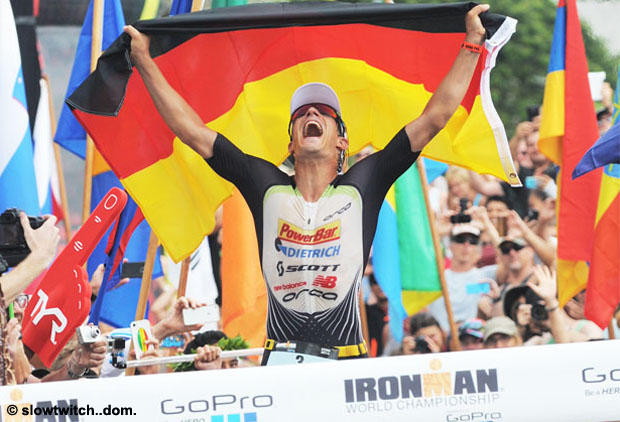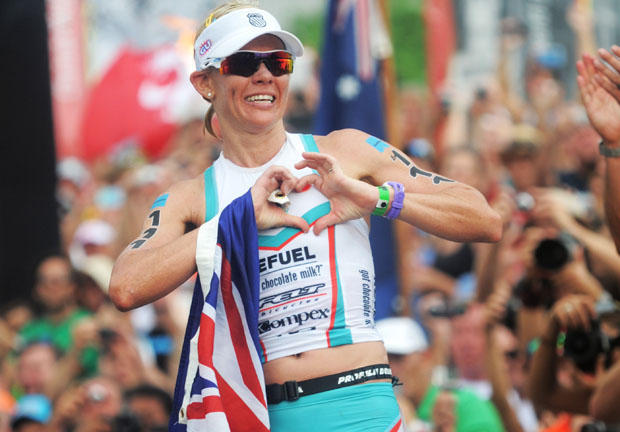Fiction! How Frodeno and Ryf might be beaten
First things first. Anyone could get injured before or during the race (Tim Don gets hit by a car, Natascha Badmann crashes at Mile 8), get sick (Chrissie Wellington gets food poisoning the night before the 2010 Ironman), or have a mechanical issue (myriad flat tires). For purposes of this imaginary exercise, such common misadventures do not count.
This article will outline how by dint of brilliant (but plausible) performances by the challengers, some daring and talented long shots could pull off a dark horse miracle this year at Kona.
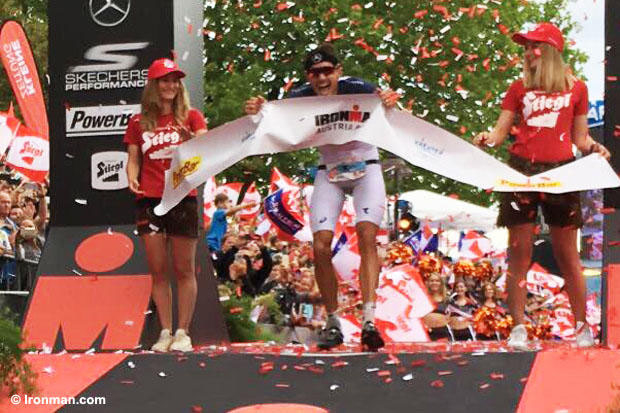
For purposes of this exercise Frodeno and Ryf are allowed to have off days. But they cannot have a disaster. These scenarios propose that the surprisers will win the race. These scenarios propose how these upsets might happen at the hands of brilliant, albeit unexpected, performances.
Historical example
Paula Newby-Fraser melted down just 400 yards from the finish in 1995. But this was not because of a random unlucky illness. Newby-Fraser rode hard into blistering winds to create a 13-minute lead over Karen Smyers at T2. But Smyers ran so hard she pressured Newby-Fraser into failing to hydrate near the end and erased her lead with a quarter mile to go. While many would argue, our verdict is that Smyers won it.
Despite their dominant victories, Frodeno and Ryf have been vulnerable
Without Mirinda Carfrae and her superior run to challenge her, Daniela Ryf towers over the 2017 Kona women’s field like a Colossus. Which is not to say luck good or bad cannot wreak havoc. Bad luck: In 2015, Ryf had a tire go flat on the bike leg. Good luck: The flat occurred two miles from the finish of the bike and she was able to limp into T2 and win the race. Bad luck: In 2016 Ryf got hypothermia from cold air and water temps and had to withdraw from Ironman Frankfurt. Good luck: Ryf took advantage to enter Challenge Roth two weeks later and won it in 8:22:04 – the third best Ironman distance women's mark. Bad luck: She had to validate her Kona entry with another Ironman right afterward – making her too tired to finish better than 4th at the Ironman 70.3 Worlds. Good luck: She was rested at Kona a month later and smashed the race record with an epic 8:46:46 time that was 23:44 faster than runner-up Carfrae. Significantly, Ryf finally broke the 3-hour run barrier at Kona for the first time with a 2:56:51 split that topped Carfrae’s run. This year there was a little drama – Ryf pulled her back a few days before Ironman South Africa but recovered well enough to win in 8:47:02. One sign of potential decline – she failed to break Chrissie Wellington’s Ironman distance world best at Challenge Roth – winning in 8:40:03 but falling 22 minutes short of Chrissie’s mark and 15 minutes short of her own time last year at Roth.
Just by the record, Jan Frodeno is the clutch performer of the sport, as attested by his 2008 Olympic Triathlon gold medal, his 2014 silver and 2015 gold at the 70.3 Worlds, his 2014 runner-up and 2015 and 2016 victories at the Ironman World Championship, and his Iron-distance world best time of 7:35:39 at Challenge Roth in 2016. After his 7:57:20 winning time at Ironman Austria this year, you could say that Frodo is on track for a third Kona win and you would not be wrong.
Still, Frodeno also proves that even the mighty are vulnerable to accidents, pain, and bad luck. Early last year a calf injury left him out of action until Roth. At Kona, Frodeno confessed he was sorely tempted to drop out before finishing with a victory. “I did want to give up three times actually. I wanted to pull off. I was thinking: I will make up some excuse. Make it sound good and go home.” This year, Frodeno did not finish Oceanside 70.3 due to a mechanical issue.
Still, Frodeno combines a first pack swim, a top five bike split and a reliable 2:45 marathon on the toughest days which remains the standard for a Kona win. Last year he outswam rival Sebastian Kienle by 4:25, surrendered 5:05 to Kienle on the bike leg and outran Kienle by 3:32 for the victory. Still, Frodeno leaves room to be beaten. Last year, if not for the 5 minutes penalty for drafting, Patrick Lange theoretically would have beaten Frodeno’s winning time by 16 seconds.
THE PROTAGONISTS – MEN
Frodeno himself says that this year’s men’s field is deeper and more talented. There is newcomer Josh Amberger, the Asia Pacific Ironman champion at Cairns in 8:02:17, who will surely be at the front of the swim and should stay with the top cyclists and Frodeno into T2.
Patrick Lange, who last year became famous for breaking Mark Allen’s 27-year-old run record with a 2:39 effort, is lesser known for his 48-minute swim which put him close to Frodeno. Lange is also well known for the 5-minute penalty he incurred on the bike leg but that could not entirely account for all of his 10-minute deficit to Kienle and his 8 minutes deficit to Frodeno at T2. Lange has shown he can be closer to the front on the bike leg, which should make him a threat to topple Frodo if he can duplicate his effort on the run. The big if – Lange suffered a leg injury early this year which prevented him from run training for seven weeks and led to a 6th at Frankfurt – a far cry from his win at Ironman Texas last year. The counter argument is that Lange won late season Ruegen 70.3 with a world class 1:11 half marathon, which indicates his run is back, combined with the fact that he is well rested.
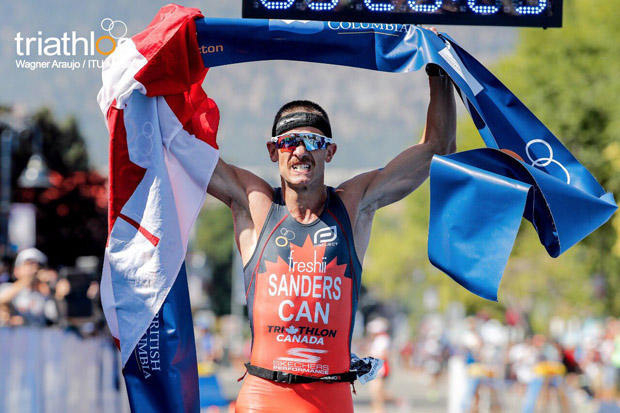
Like Lange, Lionel Sanders has tons of talent, but unlike his record times at Ironman Arizona, his Kona record is disappointing. In 2015 he was 15th and last year he ended up walking much of run and finished 29th. “Last year was a humbling experience,” said Sanders. “I did not prepare the way this race demands and I came here to redeem myself and show I will never disrespect Kona again.” This year Sanders focused on cutting his deficit on the swim from 8:47 to under 4 minutes. At Ironman Arizona last November, Sanders posted world class bike (4:04:38) and run (2:42:31) splits. If applied to Kona, even adding several minutes due to heat, humidity, hills and wind, that puts Sanders in contention.
“I would say Kona is 15 watts skewed – 315 watts here is like 330 watts in Arizona. That is about what I predict I can do here this year.” If he swims within 4 minutes of the leaders, can he and Kienle team up and ride to the front without expending too much energy? “I think I have proved I can ride with or better than Kienle,” said Sanders. “I was leading the pack every time I raced him this year.”
Frodeno’s longtime rival Sebastian Kienle has proven he can battle with the two-time winner. In 2014, Sebi won the fight. Last year, Sebi surrendered 4 minutes to Frodo on the swim, gained back all that and more on the bike, then battled to even halfway on the run. If not for a 4-minutes slower than front pack swim, Kienle would have more Kona wins. His bike is a guaranteed top 3 at Kona and he proved he has a Kona-winning run with his 2:44:12 run at 2016 Ironman Frankfurt and his 2:49:03 run at Kona last year.
At age 31, American Matt Hanson proved he should be in the mix at Kona after a 7:52:44 win at the Ironman North America Championship at Texas where he posted a well-balanced 51:46 swim, a second-best 4:13:53 bike split and second-best 2:42:07 run.
After a 2nd place in 2014 and a 6th last year, plus a sub 8-hour race at South Africa this year, Ben Hoffman should be in the race to the end.
THE MEN’S RACE
On a choppy day, Josh Amberger should lead the swim in 49 minutes, followed a minute later by Frodeno, then Lange at 51, Hanson and Hoffman at 52 minutes. Crucially, Kienle should finish in 53 minutes and Sanders in 54.
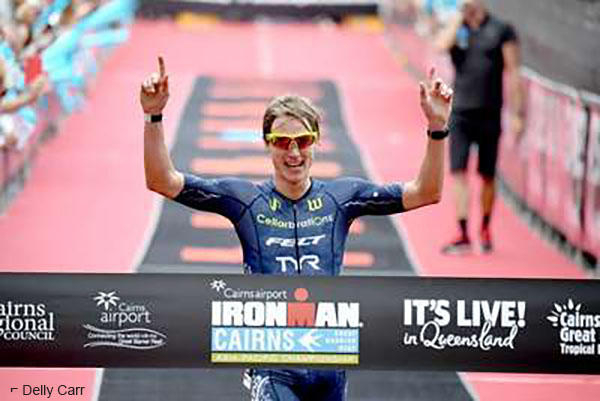
The men start the bike in a light rain, As expected Amberger leads the pack past the airport, Waikoloa and up the hill past Kawaihae. Tempted, with something in reserve, Frodeno follows at a discreet distance but makes a move to narrow the gap on the climb to Hawi. Lange, Hanson and Hoffman join a large pack some three minutes behind the leader. Working together at legal distance, Kienle and Sanders slice through the field to join the chasers at Kawaihae, where the wind picks up, then move to the front of the line at Hawi.
On the downhill back from Hawi, Sanders edges in front of Kienle and the duo close in on Frodeno and Amberger. Amberger holds off Frodeno until Waikoloa, whereupon Sanders and Kienle blast through.
Frodeno closely monitors Sanders and notices that the Canadian looks fresh. Concerned about Sanders’ 2:42 marathon speed, Frodo pushes to ride with Sanders, letting Kienle take a few minutes lead. By Waikoloa, Lange trails by 4 minutes as Hanson and Hoffman trail by 5 and 6 minutes.
At the conclusion of the ride, Kienle arrives first at T2, Sanders next at 1 minute down, Frodeno 2 minutes back, Amberger fading at 3 and a half minutes back, Lange at 4 and a half minutes arrears, and Hanson and Hoffman 7 minutes down.
Five miles south on Ali’i Drive, Sanders moves past Kienle, followed closely by Frodeno. Lange gets in gear, 4 minutes back and a few second ahead of Amberger. Five miles into the run, Hanson and Hoffman are running together six minutes back.
On the climb up Palani at 9 miles, Frodeno and Sanders are running side by side, 90 seconds ahead of Kienle and 3:45 ahead of Lange. Hoffman and Hanson are 5 minutes back.
Unlike the year before, Sanders assiduously maintains his hydration and nutrition and freewheels along next to Frodeno, who tries and fails to make a move on the Queen K to The Natural Energy Lab of Hawaii. Coming out of the Lab on a hot sunny day, Sanders grinds a few yards ahead of Frodeno, who coolly shadows the Canadian.
Coming out of the Natural Energy Lab, Frodeno leads – just a few steps ahead of Sanders, who takes gels and water.
At Mile 23, on the long incline made famous as Mark and Dave Hill, Sanders uses his power to slowly edge away. Frodeno, worn thin by several surges on the bike, cannot answer and slowly falls back as if in a dream. By this mile marker, Lange has cut his gap to 2:30. Hanson leaves Hoffman behind and passes Kienle.
Coming down Palani one mile from the end, Sanders feels a cramp arising and looks around to see Frodeno 30 seconds back. Gathering himself, Sanders splashes water on his legs and regains equilibrium. At the bottom of Palani, Lange passes Frodeno, who surges back. Despite his distress, Sanders finishes off a 2:46 marathon on a hot day with a 15 seconds margin of victory over Lange and 20 seconds on Frodeno. Hanson closes with a 2:42 marathon to takes 4th, Hoffman takes 5th and Kienle 6th.
THE PROTAGONISTS – WOMEN
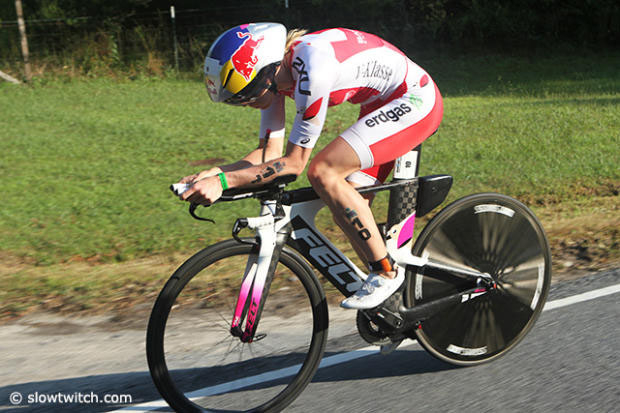
Top triathlon journalist Kevin McKinnon says, “At this time, no one can beat Daniela Ryf when she is having a great day. No one can beat her when she is having a good day. But she can be beat when she is having a fair to mediocre day.” This will be one of those rare days.
With her 2016 2:56:51 Kona run split and no Carfrae to battle, Ryf outpaces the proven runs of her two new top challengers Sarah Crowley and Lucy Charles and consistent podium finisher Rachel Joyce. Ryf says she welcomes the opportunity to chase super swimmers and strong cyclists Lucy Charles and Lauren Brandon. “This is a very challenging year,” says Ryf. “The swim is going to be fast. Maybe the fastest swim we have ever seen. It will be fun to chase them. I kind of like chasing. There are a lot of new girls who can lead the swim and ride hard. I am sure they will not hold back. So, we will see.”
Lucy Charles of Great Britain is just 24, and has had a brilliant 2017 season. She won the severely challenging Ironman Lanzarote with a top swim and a race record bike split. While her 3:18 run brought her back to earth, she still won by double digit minutes. Charles proved she belonged in elite company with a second place at Ironman Frankfurt in a time of 8:51:50, 3:52 behind Sarah Crowley of Australia at the end of a 3:13 marathon – her Achilles heel. Charles may not win but she will be the straw that stirs the drink on the swim and run.
After a modest 15th place debut at Kona last year, Sarah Crowley burst into prominence this year with Ironman Regional Championship wins at Asia Pacific and Europe. Crowley finished Cairns in 8:58:14 and Frankfurt in 8:47:58 and took the ITU long distance worlds in Penticton by 3:41 over Helle Frederiksen. If she has a weakness so far, her best Ironman runs are 3:05 and 3:06. And her bike is not dominant – her 4:40 split at Frankfurt benefited from a 3-kilometer short course.
Lauren Brandon’s run lags far behind the top Ironman women. But her sizzling swim and excellent bike will have her play a part as the race unfolds.
Rachel Joyce has had a smooth arc of improvement in 2017 after taking a year off for the birth of her first child Archie. She took 7th at Oceanside 70.3, 4th at St George 70.3, a win at Ironman Boulder in 9:13:32, 7:10 ahead of Heather Jackson, dropped back a little with a 4th at Ironman Canada, and then regained momentum with a win at Ironman Mont Tremblant in 9:19:08.
At age 39, a year off may cast doubt on her chances at Kona. But no one outside of Ryf and Carfrae has been more consistent over the past four years at Kona where she scored 2nd in 2013 with a time of 8:57:28, 3rd in 2014 and 2nd again in 2015 behind Ryf. The 2011 ITU Long Distance World Champion and 2012 Challenge Roth winner has been so consistent over such a long period that she must be rated higher than her recent performances.
THE WOMEN’S RACE
Last year, Daniela Ryf emerged 10th in the women’s swim wave, with a 52:50 split that put her just 14 seconds off the top. This year Lucy Charles and Lauren Brandon finish in 49 minutes and should put 3 minutes on Ryf, with Rachel Joyce 2 minutes further back and Sarah Crowley 2 more minutes arrears. While Ryf soldiers through the swim, she swallows a bit of sea water and starts the bike with an uncomfortable feeling.
With no troubles that led to multiple attempts to validate her Kona start last year, Ryf has fewer races under her belt and enjoys the confidence of a dominating third win at Ironman 70.3 Worlds. So, she eases into the bike leg then works into the chase.
Admittedly, this writer finds it hard to create a scenario to suggest Ryf can be caught when all is well. So, suppose the salt water she swallowed left her throwing up until the stomach clears. Then she falls behind on her hydration and weakens until she arrives at her special needs bag. By this time, Charles and Crowley maintain a 5 minutes lead on Ryf, with Joyce and Brandon three minutes behind the champion.
At T2, Crowley leads Charles by 30 seconds, with Ryf revived and 4:30 behind the leaders. After her troubles with digestion, can Ryf unleash another 2:56 marathon and erase her 5 minutes deficit on women whose best previous Ironman marathons are above 3:03?
Ryf fights against her gastrointestinal troubles, and passes Charles after summiting Palani. Meanwhile, Crowley is having the race of her life and increases her lead on Ryf to 6 minutes entering the Energy Lab.
Aptly, Ryf rallies in the Energy Lab and cuts the deficit to 4 minutes with a 10k to go. Crowley gets encouragement from her coaches and settles into a smooth stride and a perfect 7:15 per mile pace. Feeling at her best for the moment, Ryf advances on Crowley at 20 seconds per mile.
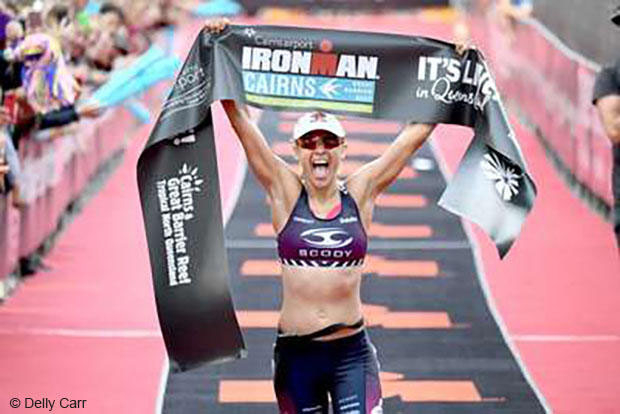
Finally, at thy end, the newest TriSutto athlete – Brett Sutton coaches Daniela Ryf, TriSutto Associate Cameron Watt coaches Sarah Crowley – finishes off the upset of the decade by a 30 seconds margin of victory. Rachel Joyce finishes strong to take third, just ahead of Heather Jackson and Melissa Hauschildt, Lucy Charles takes 6th, and Lauren Brandon pushes hard to take 12th.



